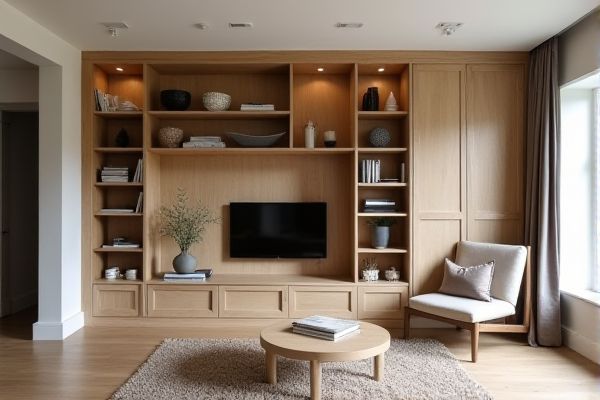
Built-in storage offers a seamless, space-saving solution that integrates directly into your room's architecture, maximizing efficiency and aesthetic appeal. If you're considering whether built-in storage or freestanding storage best suits your needs, explore the rest of the article to discover the advantages of each option.
Table of Comparison
| Feature | Built-in Storage | Freestanding Storage |
|---|---|---|
| Installation | Permanent, integrated into walls or cabinetry | Portable, standalone units |
| Customization | Highly customizable for specific spaces | Limited customization, standard sizes |
| Space Efficiency | Maximizes available space | Requires additional floor space |
| Cost | Higher installation and material cost | Generally lower upfront cost |
| Mobility | Fixed, not movable | Easy to move and rearrange |
| Durability | Often more durable and integrated | Varies by material and construction |
| Style Integration | Seamlessly blends with room design | Standalone style, may contrast room |
Introduction to Built-In and Freestanding Storage
Built-in storage integrates seamlessly with architectural elements, offering a customized fit that maximizes space efficiency and maintains a cohesive interior design. Freestanding storage units provide flexibility and mobility, allowing easy repositioning and adaptation to changing needs or room layouts. Both storage types serve distinct functional and aesthetic purposes, catering to various household or office organization requirements.
Key Differences Between Built-In and Freestanding Storage
Built-in storage is integrated into the structure of a room, offering a seamless and space-saving design that maximizes available square footage, often customized to fit specific dimensions. Freestanding storage units provide flexibility and mobility, allowing easy rearrangement or replacement to adapt to changing needs and interiors. Key differences include permanence, with built-in storage being fixed, and versatility, where freestanding options cater to more dynamic living environments.
Space Utilization: Built-In vs Freestanding
Built-in storage maximizes space utilization by integrating seamlessly into walls, corners, or under stairs, eliminating unused gaps and creating a streamlined appearance. Freestanding storage offers flexibility in placement but often results in less efficient use of available space due to its fixed dimensions and footprint. Optimizing storage capacity favors built-in units, especially in smaller or irregularly shaped rooms.
Design Flexibility and Customization
Built-in storage offers seamless integration with your existing architecture, providing a tailored and cohesive look that maximizes space efficiency. Freestanding storage units deliver greater design flexibility, allowing you to rearrange, update, or replace pieces as your style and needs evolve. Your choice depends on whether you prioritize long-term customization or adaptable, movable storage solutions.
Installation Process and Complexity
Built-in storage requires professional installation involving precise measurements, customization, and often structural modifications, making the process more complex and time-consuming. Freestanding storage units offer a simpler installation experience, usually requiring minimal assembly and no permanent attachment to walls or floors, allowing greater flexibility and easier relocation. Your choice depends on whether you prefer a seamless, integrated look or a quick, hassle-free setup.
Cost Comparison and Value for Money
Built-in storage typically incurs higher upfront costs due to custom design, materials, and installation, whereas freestanding storage offers more budget-friendly options with easy replacement or relocation. Despite the investment, built-in storage can add significant value to a property by maximizing space efficiency and providing a seamless aesthetic, which often results in better long-term returns. Freestanding storage delivers flexibility and immediate cost savings but may lack the durability and integrated appeal that enhance overall home value.
Maintenance and Longevity Considerations
Built-in storage typically offers enhanced durability due to its secure integration within walls or cabinetry, reducing exposure to wear and tear while requiring minimal maintenance over time. Freestanding storage, while easier to move and customize, may experience more frequent wear on surfaces and hardware, necessitating regular upkeep such as tightening screws or refinishing to maintain longevity. Your choice should consider the balance between ease of repair and the expected lifespan of materials to ensure lasting functionality.
Aesthetic Impact on Interior Design
Built-in storage seamlessly integrates with interior architecture, enhancing room aesthetics by providing a clean, cohesive look that maximizes space without visual clutter. Freestanding storage offers flexibility and can serve as a design statement or focal point, allowing for easy rearrangement to suit changing decor styles. Choosing built-in storage typically results in a minimalist, streamlined appearance, while freestanding pieces contribute personality and texture to the overall interior design.
Mobility and Adaptability Factors
Freestanding storage offers superior mobility, allowing you to easily rearrange or relocate units to adapt to changing spaces or needs. Built-in storage is fixed, providing a seamless, customized fit but limiting flexibility for future modifications or moves. Choosing between these options depends on your preference for adaptability and the likelihood of reconfiguring your storage layout.
Choosing the Right Storage Solution for Your Needs
Built-in storage offers a seamless, space-saving option ideal for maximizing room efficiency and customizing your interior design, while freestanding storage provides flexibility and ease of relocation to adapt to changing needs. Your choice depends on factors such as available space, budget, and long-term usage goals. Prioritizing functionality, aesthetic cohesion, and accessibility ensures you select the right storage solution tailored to your lifestyle.
 homyna.com
homyna.com